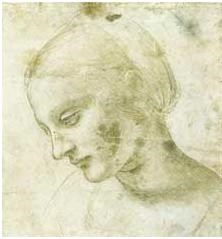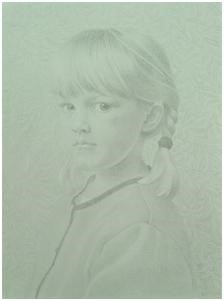Silverpoint, or metal point, drawing as an art form has changed little over the centuries of its distinguished history. The artist working in silverpoint today has an intimate connection to the work of such revered artists as da Vinci and Rembrandt, as well as more recently, Picasso and Joseph Stella. As tiny particles of metal are left behind on a slightly abrasive ground, metal point drawing offers the ability to achieve lasting, exquisitely detailed lines that won’t smudge. If different types of metal are used within a piece, over time oxidation of the different metals will impart subtle shifts in the tonality of the lines.

Silverpoint is a drawing instrument composed of a small, pointed metal tip, usually of silver, encased in a holder. Most practiced during the Renaissance by such artists as Jan van Eyck, Leonardo da Vinci, Albrecht Durer and Raphael and is the ancestor of the modern graphite pencil.
Silverpoint is used little today except by a few people who take an interest in traditional artists’ materials, yet it was a favorite technique of the old masters.
The disuse of silverpoint, after graphite sticks came into use during the 17th century, is one of the most curious details of technical art history. It is peculiar that an instrument once used by the most famous artists who ever drew on paper should have come to be neglected by their successors, and neglected and almost lost the tradition of its use. Despite the modern tendency to revive the use of traditional art techniques, silverpoint is almost entirely neglected. Fortunately, this situation appears to be changing today.
The neglect of silverpoint is regrettable because it has distinctive and valuable qualities of its own. It is a hard pencil that hardly wears down, does not break or require sharpening, and gives a dark grey line of the most intense clearness and subtlety. It is such a drawing instrument that a lover of perfection in form would naturally be tempted to select a refined stylus that literally and truly encourages refinement of style.
Silverpoint consists of a short length of silver wire sharpened so that it will make a fine line without piercing the paper. Set in a mechanical pencil holder, it resembles a drafting pencil, and the resemblance is not merely external, for the work done has similar though not identical qualities to it. The property of a drafting pencil is to make a line of uniform thickness. At first glance, this does not appear to be an advantage in fine arts. The graphite or charcoal pencil, with which a thin or a thick line, or a line thick at one place and thin at another, can be drawn by simply varying the degree of pressure or the angle by which it is held, is a more pliable tool than the silverpoint stylus. Nonetheless, it is a mistake to condemn this technique when great masters have used it. The techniques they used were often limited, yet the results were masterful.

We must remember, too, that the stylus can be made with differently shaped points and sharpened to varying degrees, and that the artist can keep two or three different styli if required. The common practice, however, seems to have been to draw with one point, and that rather a sharp one.
The major objection to silverpoint is that silver does not mark unprepared paper. Paper can easily be prepared as it was by the old masters, and when that is done the marks of the point are a dark grey, equivalent in tone to a hard lead pencil.
Golden Silver Point Drawing Ground is a thin ground of opaque white is all the preparation needed for paper. The white may be tinted with any color or used as is. The old masters prepared papers in a great variety of tints without an apparent rationale to the colors.
It is not difficult to tint your own paper, and this provides the advantage of precisely getting the value and hues that you like best and those most perfectly suited to the intended drawing. The paper should be smooth and, if lightweight, should be stretched as if for watercolor painting, and the ground applied evenly with a wide soft-hair brush.

An advantage of tinted paper is the extended range of tonal values that are possible. The silver or metal lines appear darker over tinted paper, and bright highlights can be introduced with white paint. The old masters often heightened the tonal value of the tinted paper with white. These harmonize best with the lines of the silverpoint when they are sharp and fine, and applied with the point of a small sable brush. White paint can be made with egg yolk, gum arabic, animal collagen or casein. The old masters used lead white to heighten their drawings. These lines of lead white often turned black due to polluted air containing hydrogen sulfide. In the late 19th century, Philip Hamerton describes one such drawing by Pietro Perugino of an angel leading a youth. “The drawing is in silverpoint on a greenish ground, and what were intended to be highlights in thin sharp touches of white, are now black lines.”[1] This type of discoloration is reversible and has been restored in this drawing at the British Museum today.
Today, artists have an extended selection of titanium dioxide, zinc oxide and barium sulfate (called barite or blanc fixe) as whites for heightening the value of tinted paper. Each white has its own individual qualities, such as opacity, color temperature, specific gravity, etc. These pigments can be tempered with one of the above-mentioned mediums and brushed on with the fine point of a small brush.
This post is adapted from The Graphic Arts by Philip Gilbert Hamerton.
